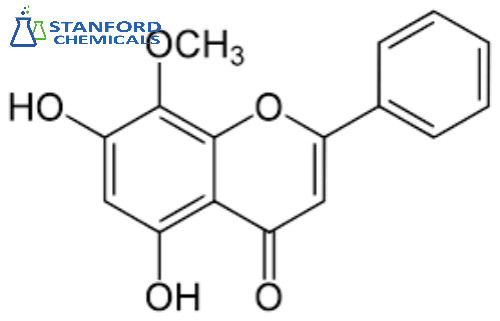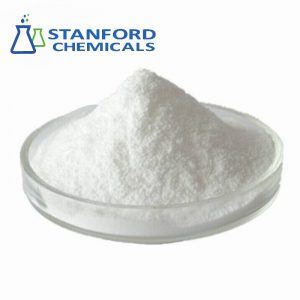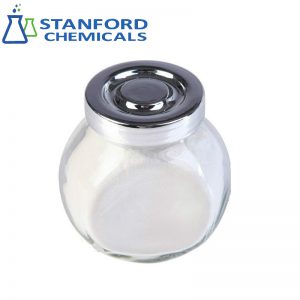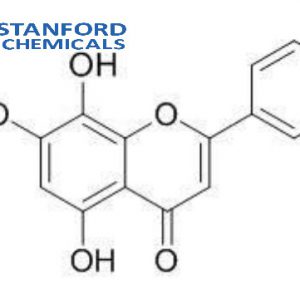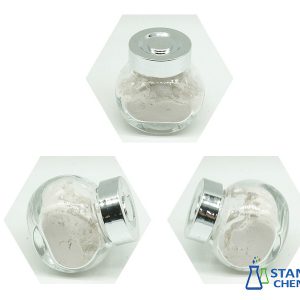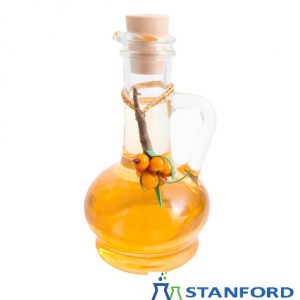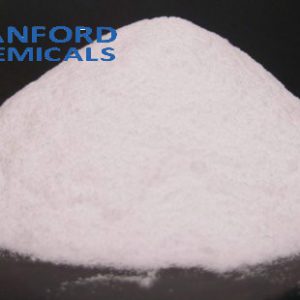- Home
- Foods and Nutraceuticals
- 030-000-365 Wogonin (CAS: 632-85-9)
030-000-365 Wogonin (CAS: 632-85-9)
| Product Name | Wogonin |
| CAS No. | 632-85-9 |
| Appearance | Yellow powder |
| Type | Flavone |
| Keywords | Wogonin, Vogonin |
| Related products | Medical Grade Sodium Hyaluronate, Chondroitin Sulfate, Dihydromyricetin, Herbal Extract |
| Synonyms | Vogonin, Norwogonin 8-methyl ether, 5,7-dihydroxy-8-methoxyflavone |
- Description
Description
Wogonin (CAS: 632-85-9) Description
Wogonin (CAS: 632-85-9) is an O-methylated flavone, a flavonoid-like chemical compound that was found in Scutellaria baicalensis. The glycosides of wogonin are known as wogonosides. For example, oroxindin is a wogonin glucuronide isolated from Oroxylum Indicum. It is one of the active ingredients of Sho-Saiko-To, a Japanese herbal supplement.
Wogonin (CAS: 632-85-9) Specifications
| Product Name | Wogonin |
| CAS Registry Number | 632-85-9 |
| Molecular Formula | C16H12O5 |
| Molecular Weight | 284.26 g/mol |
| Assay | ≥98% |
| Pubchem | 5281703 |
Wogonin (CAS: 632-85-9) Applications:
Wogonin (5,7-dihydroxy-8-methoxyflavone) is an O-methylated flavone under the category of flavonoid, and is mainly obtained from Scutellaria radix. Wogonin has an anti-inflammatory effect through suppression of iNOS and COX-2 expression. Additionally, Wogonin has potential benefits in inflammatory colorectal carcinogenesis, mainly through suppression of NF-κB and activation of Nrf2 signaling pathways in HCT116 cells and THP-1 cells, which has been used to treat lung inflammation. Its anti-inflammatory properties are associated with the inhibition of NO, cytokines, chemokines, and growth factors in dsRNA-induced macrophages via the calcium-STAT pathway. Wogonin was found to be able to potentially mitigate hyperglycemia-related cardiomyocyte impairment through anti-inflammatory and antioxidant mechanisms. In addition, wogonin remarkably suppressed PPAR-γ-meditated phosphorylation and activation of NF-κB-P65. Overall, wogonin has an anti-inflammatory effect through suppression of inflammatory mediators, including IL-6, COX-2, PGE2, iNOS, and NO in IL-1β-stimulated osteoarthritis chondrocytes.[1]
Studies have shown inhibitory effects of wogonin on a number of different cancer cells. The mechanisms of action are modulation of the p53 signaling pathway, G1 phase arrest, antitumor angiogenesis by inhibition of VEGF, and apoptosis through the mitochondrial pathway. These works indicate that wogonin is a new anticancer agent with the enhancement of the curative effect on chemo-insensitive tumors that may clinically benefit ovarian cancer patients. Polier et al. demonstrate for the first time that wogonin and structurally related natural flavones, for example, apigenin, chrysin, and luteolin, are inhibitors of cyclin-dependent kinase 9 (CDK9) and block phosphorylation of the carboxy-terminal domain of RNA polymerase II. This effect leads to reduced RNA synthesis and subsequently rapid down-regulation of the short-lived anti-apoptotic protein myeloid cell leukemia 1 (Mcl-1) resulting in apoptosis induction in cancer cells.[2]
Reference
RajeshShukla, VikasPandey, Gautam P.Vadnere, SantramLodhi: Chapter 18 – Role of Flavonoids in Management of Inflammatory Disorders. Bioactive Food as Dietary Interventions for Arthritis and Related Inflammatory Diseases (Second Edition) 2019, Pages 293-322
AhmadSalimi, JalalPourahmad: Chapter 16 – Role of Natural Compounds in Prevention and Treatment of Chronic Lymphocytic Leukemia. Polyphenols: Prevention and Treatment of Human Disease (Second Edition)
2018, Pages 195-203
[1] RajeshShukla, VikasPandey, Gautam P.Vadnere, SantramLodhi: Chapter 18 – Role of Flavonoids in Management of Inflammatory Disorders. Bioactive Food as Dietary Interventions for Arthritis and Related Inflammatory Diseases (Second Edition) 2019, Pages 293-322
[2] AhmadSalimi, JalalPourahmad: Chapter 16 – Role of Natural Compounds in Prevention and Treatment of Chronic Lymphocytic Leukemia. Polyphenols: Prevention and Treatment of Human Disease (Second Edition) 2018, Pages 195-203

